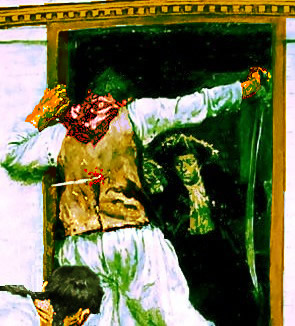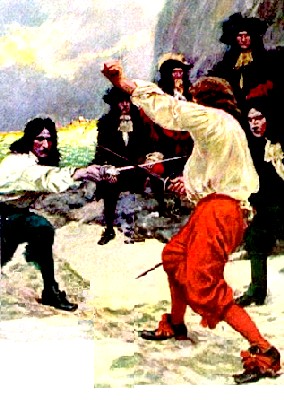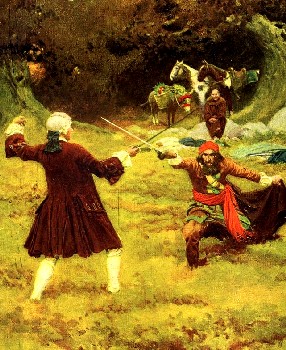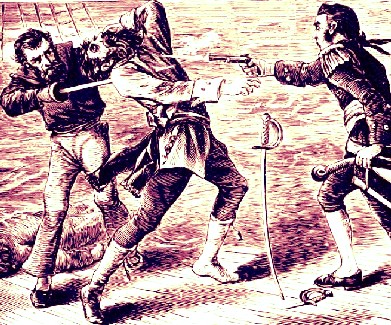
Torso Wound Care Page Menu: 1 2 3 4 5 6 7 8 9 10 Next>>
Torso Wound Care During the Golden Age of Piracy, Page 1
"For doubtfull hope is better than certain despair." (Ambroise Paré, The Workes of that Famous Chirurgion Ambrose Parey, 1649, p. 303)
Wounds of the torso were often viewed with grave concern by physicians and surgeons during the golden age of piracy as French surgeon Paré's comment from his chapter on the cure of wounds of the belly suggests. Surgeons at this time knew that many such wounds, particularly those which penetrated deeply into the torso risking damage to the organs it contained, were fatal. However, the surgeon's role in such situations was often limited to doing what good he could and hoping for the best, a sentiment reflected by Paré.

Artist: Howard Pyle (1895)
Many surgeons at this time divided such wounds broadly into two types: those which were simple, not piercing far enough into the chest or abdomen to damage the organs and those which were deeper and thus more troublesome. They further divided such wounds by location into two other categories: those of the chest and those of the abdomen. With this in mind, this article examines how they handled the general diagnoses and treatment of wounds of the chest and then moves on to do the same for wounds of the abdomen.
The theory of healing these wounds is actually built upon the five steps used to heal simple broken-skin wounds. These five steps include:
Step 1: Remove foreign objects.
Step 2: Bring the wound lips together.
Step 3: Keep the wound lips together.
Step 4: Maintain wound temperament.
Step 5: Remedy complications.
Since a detailed discussion of how these five steps were used can found in the article on simple wounds, they will not be addressed here. This article will instead focus on the more unique aspects of wounds of the chest and abdomen as well as addressing some unique treatments used in such wounds. Among these unique aspects are the treatment of gunshot wounds to the torso. In addition to the more generic treatment plans for the thorax and abdomen, many period surgeons also discuss diagnoses and treatments of wounds to particular organs including wounds to the heart, lungs, liver, kidneys, spleen, stomach, intestines, spine and bladder. Although these discussions are not as full as those of the chest and abdoment, they will be addressed in as much detail as was appropriate to the time period.
Surviving Wounds of the Torso in the Golden Age of Piracy
There are only a few references to wounds of the torso in the pirate literature. Even fewer of these accounts suggest the victim actually survived his wound. Several of the accounts indicate that torso wounds immediately killed the man wounded. Such wounds were considered so deadly, other accounts suggest that the man inflicting the wound did so with the intent to kill his victim.

Artist: Howard Pyle
From Harper's Monthly Magazine
(October, 1909)
When some of his crew attempted to escape in a consort ship, pirate Captain John Phillips caught up with them and boarded their ship and accused one of the crew of being part of the plot. In a fit of anger, "he damned him, and swore he would send him to hell, and instantly ran him through the body with his sword, in such a manner that he twisted the point of it off, leaving it in his back bone."2
Not everyone died according to the intent of the swordsman. After pirate Bartholomew Roberts killed John Jones' messmate in a fit of pique, Jones cursed the captain. "Roberts hearing Jones's Invective ran to him with a Sword, and ran him into the Body; who, notwithstanding his Wound, seized the Captain, threw him over a Gun, and beat him handsomely."3
One Williams, Lieutenant of pirate captain John Gow's crew, attacked Gow because they decided not to engage a clearly superior ship. Fortunately for Gow, Williams' gun failed to fire. Two men standing near Williams "and seeing him so furious, flew at him immediately, and each of them fired a Pistol att him, one shot him thro’ the Arm, and the other into his Belly, at which he fell, and the Men about him laid hold of him to throw him over Board, believing he was dead, but as they lifted him up, he started violently out of their Hands, and leaped directly into the Hold, and from thence run desperately into the Powder-Room, with his Pistol cock’d in his Hand, swearing he would blow them all up; and had certainly done it, if they had not seized him just as he had gotten the Scuttle open"4. Williams failed to set fire to the powder, winding up handcuffed below with the rest of the pirates' prisoners. They eventually gave him to a Bristol-based prize ship, instructing the captain "to deliver him on Board the first English Man of War they should meet with, in order to his being hanged for a Pirate (so they jeeringly called him)"5. Williams survived his stomach wound long enough to be tried and hung.
Like these examples, most pirate accounts do not give a lot of detail on such wounds, with many referring to them as 'wounds of the body' (as opposed to those of the head or limbs). When James Greenham was helping to trim the sails of one of Roberts' ships, it was noted that he "was shot thro' the Body" without expanding upon where in the torso he was hit.6 It is only because Greenham later gave testimony at the pirates' trial that we know he survived the wound. William May, another man

Artist: Howard Pyle
The Duel Between John Blumer and Cazaio (1907)
captured by Roberts' crew, was 'beat very much' for being smart-mouthed to the ship's quartermaster. We know he was wounded in the torso because John Tayler said at the crew's trial that "he saw the Marks of the Blows upon his Body."7 Even that is extremely vague.
Of course, when the wounded man was reporting on his wound, more detail might be expected. During his testimony, Robert Hartley, yet another man in Roberts' crew, confessed that he was one of the men who had gone after a Royal Navy vessel. During the ensuing engagement, he "received a Musket-shot thro' the muscular part of the Abdomen in the Action with the Swallow, but says it was not Eagerness of a Portugueze Prize, as they supposed her to be, that induced him to a readiness of going"8.
Edward Low had a tendency to mete out brutal punishment to those who offended him, even if they did so unintentionally. Captain Welland of the ship Amsterdam Merchant had the misfortune to be from New England. He had to be punished, "as Low let none of that Country depart without some Marks of his Rage, [so] he cut off this Gentleman's Ears, slit up his Nose, and cut him in several Places of his Body, and, after plundering his Ship, let him pursue his Voyage."9 A Captain Greenman of the sloop Hopefull Betty was similarly caught by Low and, as a result, "was badly cut about his body but was able to reach Philadelphia ten days later."10
There are a few accounts of pirate captains being wounded in the abdomen who survived for very brief periods - just long enough to commit final acts of defiance.
The first example was Howell Davis, who, posing as the captain of a British man of war ship, was trying to convince the governor of Principe to come aboard his ship so Davis could secure him and then hold him for ransom. Unfortunately for Davis, the governer was warned by a slave who escaped from Davis' ship and swam ashore. When Davis landed on Principe with his fellow pirates, not suspecting that his plan was known to the governor,

Artist: J.B. Power
Death of Blackbeard, From Captain William Kidd and the buccaneers
who ravaged America (1874)
a whole Volly was fired upon them; they every Man dropp'd... Davis was shot through the Bowels [probably referring to the intestines], yet he rise again, and made a weak Effort to get away, but his Strength soon forsook him, and he dropp'd down dead; just as he fell, he perceived he was followed, and drawing out his Pistols, fire them at his Pursuers; Thus like a game Cock, giving a dying Blow, that he might not fall unrevenged.11
Perhaps the most durable example was Blackbeard himself. Captain Johnson records his stalwart final battle with naval Lieutenant Robert Maynard where the pirate captain received several such wounds:
They were now closely and warmly engaged, the Lieutenant and twelve Men, against Blackbeard and fourteen, till the Sea was tinctur'd with Blood round the Vessel; Black-beard received a Shot into his Body from the Pistol that Lieutenant Maynard discharg'd, yet he stood his Ground, and fought with great Fury, till he received five and twenty Wounds, and five of them by Shot.12
1 For examples, see Ed Fox, "48. Nicholas Simmons", Pirates in Their Own Words, 2014, p. 241; Fox, "62. The Trial of Nicholas Simonds and others", p. 334; 2 Fox, "47. John Fillmore's narrative", p. 229; 3 Captain Charles Johnson, A general history of the pirates, 2nd Edition, 1724, p. 249; 4 Select and Impartial Accounts of the Lives, Behavior, and Dying-Words Of the most Remarkable Convicts, Vol. II, 1745, p. 223-4; 5 Select and Impartial Accounts, p. 225; 6 "Pyrates Lately taken by Captain OGLE", 1723, p. 32; 7 "Pyrates Lately taken by Captain OGLE", p. 14; 8 "Pyrates Lately taken by Captain OGLE", p. 71; 9 Johnson, p. 379-80; 10 George Francis Dow and John Henry Edmonds, The Pirates of the New England Coast 1630-1730, 1996, p. 207; 11 Johnson, p. 207; 12 Johnson, p. 84

